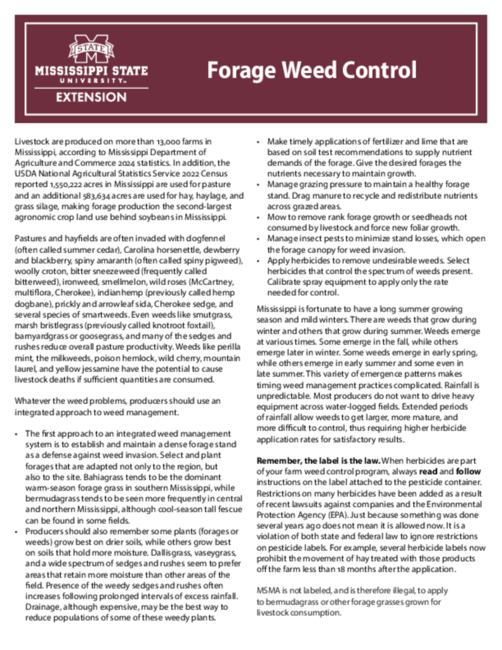P1532-1
Forage Weed Control
Livestock are produced on more than 13,000 farms in Mississippi, according to Mississippi Department of Agriculture and Commerce 2024 statistics. In addition, the USDA National Agricultural Statistics Service 2022 Census reported 1,550,222 acres in Mississippi are used for pasture and an additional 583,634 acres are used for hay, haylage, and grass silage, making forage production the second-largest agronomic crop land use behind soybeans in Mississippi.
Pastures and hayfields are often invaded with dogfennel (often called summer cedar), Carolina horsenettle, dewberry and blackberry, spiny amaranth (often called spiny pigweed), woolly croton, bitter sneezeweed (frequently called bitterweed), ironweed, smellmelon, wild roses (McCartney, multiflora, Cherokee), indianhemp (previously called hemp dogbane), prickly and arrowleaf sida, Cherokee sedge, and several species of smartweeds. Even weeds like smutgrass, marsh bristlegrass (previously called knotroot foxtail), barnyardgrass or goosegrass, and many of the sedges and rushes reduce overall pasture productivity. Weeds like perilla mint, the milkweeds, poison hemlock, wild cherry, mountain laurel, and yellow jessamine have the potential to cause livestock deaths if sufficient quantities are consumed.
Whatever the weed problems, producers should use an integrated approach to weed management.
- The first approach to an integrated weed management system is to establish and maintain a dense forage stand as a defense against weed invasion. Select and plant forages that are adapted not only to the region, but also to the site. Bahiagrass tends to be the dominant warm-season forage grass in southern Mississippi, while bermudagrass tends to be seen more frequently in central and northern Mississippi, although cool-season tall fescue can be found in some fields.
- Producers should also remember some plants (forages or weeds) grow best on drier soils, while others grow best on soils that hold more moisture. Dallisgrass, vaseygrass, and a wide spectrum of sedges and rushes seem to prefer areas that retain more moisture than other areas of the field. Presence of the weedy sedges and rushes often increases following prolonged intervals of excess rainfall. Drainage, although expensive, may be the best way to reduce populations of some of these weedy plants.
- Make timely applications of fertilizer and lime that are based on soil test recommendations to supply nutrient demands of the forage. Give the desired forages the nutrients necessary to maintain growth.
- Manage grazing pressure to maintain a healthy forage stand. Drag manure to recycle and redistribute nutrients across grazed areas.
- Mow to remove rank forage growth or seedheads not consumed by livestock and force new foliar growth.
- Manage insect pests to minimize stand losses, which open the forage canopy for weed invasion.
- Apply herbicides to remove undesirable weeds. Select herbicides that control the spectrum of weeds present. Calibrate spray equipment to apply only the rate needed for control.
Mississippi is fortunate to have a long summer growing season and mild winters. There are weeds that grow during winter and others that grow during summer. Weeds emerge at various times. Some emerge in the fall, while others emerge later in winter. Some weeds emerge in early spring, while others emerge in early summer and some even in late summer. This variety of emergence patterns makes timing weed management practices complicated. Rainfall is unpredictable. Most producers do not want to drive heavy equipment across water-logged fields. Extended periods of rainfall allow weeds to get larger, more mature, and more difficult to control, thus requiring higher herbicide application rates for satisfactory results.
Remember, the label is the law. When herbicides are part of your farm weed control program, always read and follow instructions on the label attached to the pesticide container. Restrictions on many herbicides have been added as a result of recent lawsuits against companies and the Environmental Protection Agency (EPA). Just because something was done several years ago does not mean it is allowed now. It is a violation of both state and federal law to ignore restrictions on pesticide labels. For example, several herbicide labels now prohibit the movement of hay treated with those products off the farm less than 18 months after the application.
Download the PDF for the full publication.
The information given here is for educational purposes only. References to commercial products, trade names, or suppliers are made with the understanding that no endorsement is implied and that no discrimination against other products or suppliers is intended.
Publication 1532-1 (POD-11-25)
By John Byrd, PhD, Extension/Research Professor, Plant and Soil Sciences; Rocky Lemus, PhD, Extension/Research Professor, Plant and Soil Sciences; Brett Rushing, PhD, Extension/Research Professor, Coastal Plain Experiment Station; and Joshua White, PhD, Assistant Professor of Practice, Plant and Soil Sciences.
The Mississippi State University Extension Service is working to ensure all web content is accessible to all users. If you need assistance accessing any of our content, please email the webteam or call 662-325-2262.
